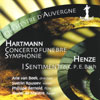Hartmann Concerto funèbre for Violin and Orchestra; Henze (I) Sentimenti
Hartmann’s concerto cements its place in the repertoire
View record and artist detailsRecord and Artist Details
Composer or Director: Karl Amadeus Hartmann, Hans Werner Henze
Genre:
Orchestral
Label: Polymnie
Magazine Review Date: 9/2006
Media Format: CD or Download
Media Runtime: 68
Mastering:
Stereo
Catalogue Number: POL610434

Tracks:
| Composition | Artist Credit |
|---|---|
| Concerto funèbre |
Karl Amadeus Hartmann, Composer
Arie van Beek, Conductor Auvergne Orchestra Karl Amadeus Hartmann, Composer |
| Symphony No. 4 |
Karl Amadeus Hartmann, Composer
Arie van Beek, Conductor Auvergne Orchestra Karl Amadeus Hartmann, Composer |
| (I) Sentimenti di C.P. E. Bach |
Hans Werner Henze, Composer
Arie van Beek, Conductor Auvergne Orchestra Hans Werner Henze, Composer |
Author: Guy Rickards
The Concerto funèbre (1939, rev 1959) is gradually emerging as a modern classic, at least on disc, with eight versions available. Roussev provides an earnest and deeply serious interpretation, successfully integrating the anti-Nazi song quotations (I use ‘anti-Nazi’ to counter the booklet which informs: ‘In 1933…Hartmann reluctantly joined the Nazi regime’, an appalling statement tantamount to calumny) into the musical whole without submerging their expressive message. With better sound than Gertler’s venerable version, Roussev does not match Zehetmair or Isabelle Faust in intensity but offers a well played alternative.
The Auvergne Orchestra’s smaller body of strings provides an intimate perspective on the concerto but in the Fourth Symphony (which evolved through a number of versions between 1938 and 1947) cannot match the weight – or finesse – of their rivals. The fuller complements used by Kubelík and Metzmacher are ideal, while the Munich CO’s virtuosity compensates for any numerical deficiency. Neither Hartmann score can have been a staple of the repertoire for the Auvergnois players, which probably accounts for some caution in their playing. In the symphony, cautious becomes over-deliberate: in the central Scherzo, the momentum Kubelík and Poppen attain naturally is here achieved far too late and only in the final bars. If Van Beek’s intent was to mitigate the issue of the Scherzo’s overwhelming climax over-balancing the whole, his solution creates a more serious problem still.
The orchestra seem most at home in the opening item, Henze’s delightful I sentimenti (1982), where the worlds of CPE Bach and Stravinsky do not so much collide as snuggle up together. Clearly, if closely, recorded.
The Auvergne Orchestra’s smaller body of strings provides an intimate perspective on the concerto but in the Fourth Symphony (which evolved through a number of versions between 1938 and 1947) cannot match the weight – or finesse – of their rivals. The fuller complements used by Kubelík and Metzmacher are ideal, while the Munich CO’s virtuosity compensates for any numerical deficiency. Neither Hartmann score can have been a staple of the repertoire for the Auvergnois players, which probably accounts for some caution in their playing. In the symphony, cautious becomes over-deliberate: in the central Scherzo, the momentum Kubelík and Poppen attain naturally is here achieved far too late and only in the final bars. If Van Beek’s intent was to mitigate the issue of the Scherzo’s overwhelming climax over-balancing the whole, his solution creates a more serious problem still.
The orchestra seem most at home in the opening item, Henze’s delightful I sentimenti (1982), where the worlds of CPE Bach and Stravinsky do not so much collide as snuggle up together. Clearly, if closely, recorded.
Discover the world's largest classical music catalogue with Presto Music.

Gramophone Digital Club
- Digital Edition
- Digital Archive
- Reviews Database
- Full website access
From £8.75 / month
Subscribe
Gramophone Full Club
- Print Edition
- Digital Edition
- Digital Archive
- Reviews Database
- Full website access
From £11.00 / month
Subscribe
If you are a library, university or other organisation that would be interested in an institutional subscription to Gramophone please click here for further information.




